Wishing everyone happy holidays and a joyful New Year from the Healthify team. Don't forget to Slip, Slop, Slap and Wrap!
Colds
Key points about colds
- A cold is a viral infection that affects your head and chest, including your nose, throat, sinuses and ears. It's not the same as influenza (the flu).
- Cold symptoms develop slowly and usually last 1 to 2 weeks.
- Because a cold is caused by a virus, antibiotics won’t help (they kill bacteria, not viruses). However, there are things you can do to feel better.
- For most people, a cold won't lead to any more serious illness.
- You can treat most colds with rest and drinking lots of fluids such as water, but know when to see a healthcare provider.
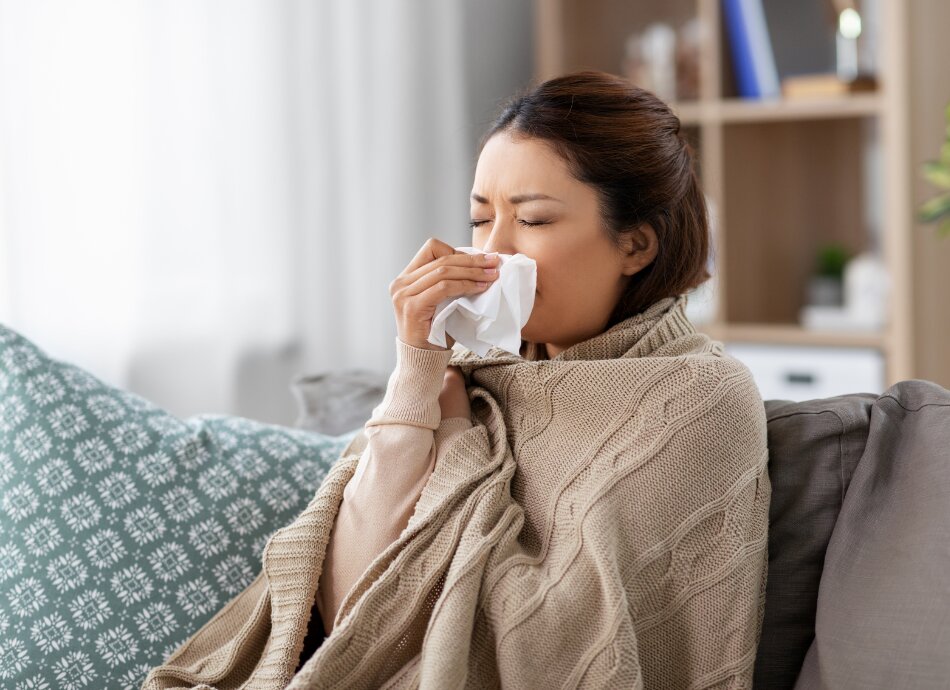
A cold is a viral infection that affects your head and chest, including your nose, throat, sinuses and ears. A cold isn't the same as the flu.
Cold symptoms usually last 1 to 2 weeks. Because a cold is caused by a virus, antibiotics won’t help (they kill bacteria, not viruses).
You can treat most colds with rest and drinking lots of fluids such as water. It's also important to take care not to spread the virus to other people.
If you have respiratory symptoms such as a cough, sore throat, shortness of breath, head cold or loss of smell, with or without fever, get a test for COVID-19.
Don't assume it's just a cold. If you're wanting to buy cold and flu medicines from your pharmacy don't go in if you've tested positive for COVID, or think you might have it.
Read more about COVID-19.
- scratchy or sore throat
- a cough
- sneezing and a runny or blocked nose
- watery eyes
- blocked ears
- a fever (temperature of 38°C or higher)
- tiredness and headache.
You usually start having cold symptoms 1 to 3 days after contact with a cold virus. The cold can spread to others even before any symptoms appear.
The best way to treat a cold is to rest and drink plenty of fluid, such as water. You can also gargle salt water, sip lemon drinks or inhale steam. However, there are potential risks associated with carrying around and breathing in steam from boiling water. It's better to sit in the bathroom (outside the shower) with the shower running hot water to create steam. Read more about steam inhalation and other ways to manage a blocked nose.
There are no medicines that cure a cold. Because colds are caused by viruses, antibiotics won't help, as they kill bacteria not viruses. Taking antibiotics when you don’t need them is bad for you and causes antibiotic resistance. However, you may feel better with medicines such as painkillers, nose drops or sprays, throat lozenges and decongestants. Talk to your healthcare provider if you have questions before taking medicines to help with the symptoms of cold.
The image below shows about how long cold symptoms have been found to last in children.
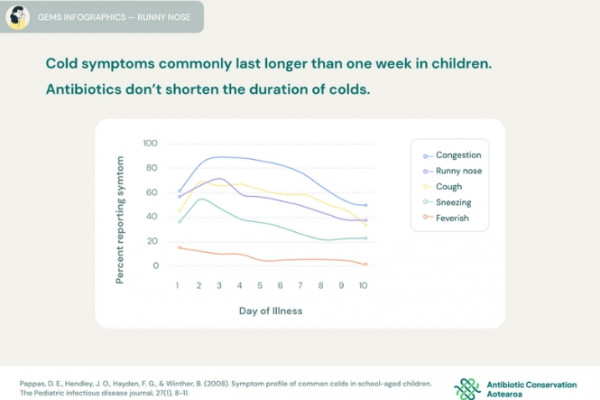
Image credit: Antibiotic Conservation Aotearoa
You won't need to see a healthcare provider if you have a cold, unless you have the following symptoms:
- an earache that gets more painful
- wheezing, shortness of breath or trouble breathing
- swollen, tender glands in your neck
- chest pain
- skin rash
- a sore throat that gets more painful, or has white or yellow spots
- a cough that gets worse or becomes painful.
- a high temperature of 39°C or above
- shaking chills
- a headache that lasts several days.
If your lips, skin or nails look blue, or you’re feeling confused, it's important to see your healthcare provider as soon as possible
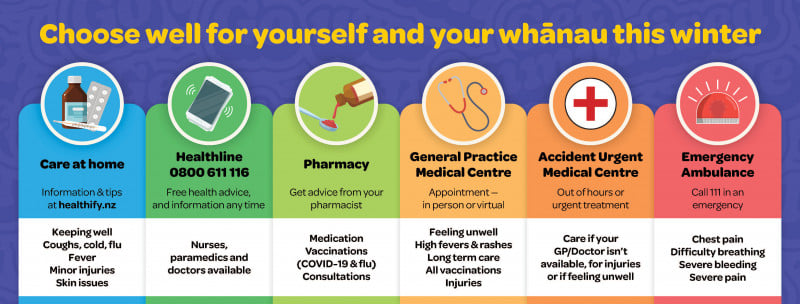 Image credit: Health New Zealand | Te Whatu Ora
Image credit: Health New Zealand | Te Whatu Ora
Regular hand washing is likely to be the best way to avoid catching a cold. Wash your hands for 20 seconds with warm water and soap followed by 20 seconds of drying,
Other things you can do include:
- Avoid close contact with people who have a cold
- Keep your hands away from your nose and mouth
- Eat a healthy diet
- Get plenty of rest
- Quit smoking
- Be physically active.
There is some limited evidence that probiotics, vitamin C and zinc may also help prevent colds.
It’s important not to spread your cold virus to other people. You can do this by:
- turning away from others and using tissues when you cough or sneeze
- washing your hands after coughing, sneezing or blowing your nose
- washing your hands often and especially before touching food, dishes, glasses and cutlery
- using paper towels in bathrooms
- not letting your nose or mouth touch public telephones or drinking fountains.
- not sharing food or eating utensils with others
- avoiding close contact with others for the first 2 to 4 days.
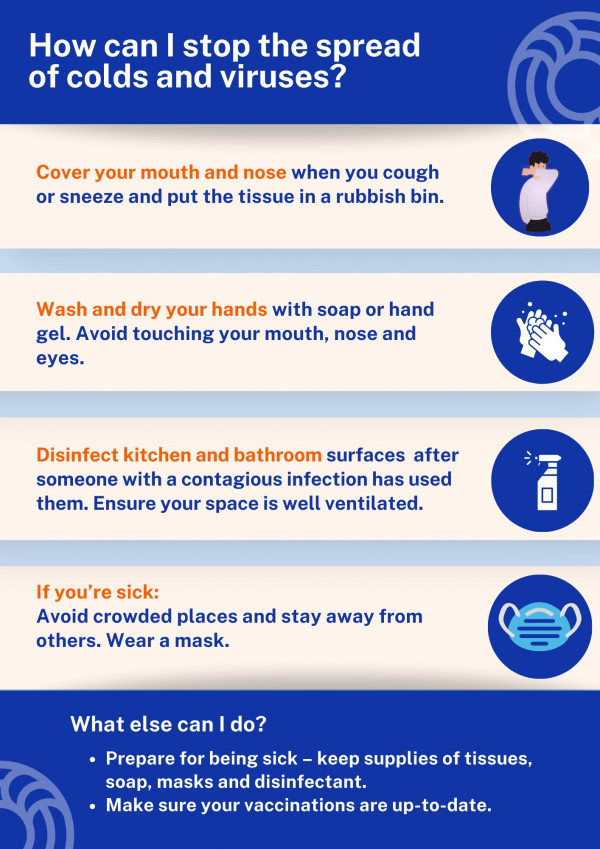
Image Credit: Healthify He Puna Waiora
Brochures
Got a cold or flu? Find out what to do factsheet(external link) Health Promotion Agency & Healthify He Puna Waiora, NZ
Cold or flu?(external link) Health Direct, Australia
Common cold fact sheet(external link) Lung Foundation, Australia
Your family & antibiotics – what you need to know(external link) Pharmac, NZ
Coughs, colds and sore-throats – manage symptoms without antibiotics(external link) Choosing Wisely, NZ
What to do when you have a cold [PDF, 167 KB] Bruce Arroll, Goodfellow Unit, NZ
Virus action plan (adult)(external link) He Ako Hiringa, NZ te reo Māori(external link), Samoan(external link), Tongan(external link), Arabic [PDF, 188 KB], Hindi(external link), Chinese (simplified) (external link)
Virus action plan (child)(external link) He Ako Hiringa, NZ te reo Māori(external link), Samoan(external link), Tongan(external link), Arabic [PDF, 214 KB], Hindi(external link), Chinese (simplified) (external link)
Apps/tools
What the colour of your snot really means – Cleveland Clinic(external link)
References
- Cold season in primary care(external link) BPAC, NZ, 2013
- Colds in adults(external link) Health New Zealand | Te Whatu Ora
- How do I treat my child's cold? (9–30 months)(external link) NHS, UK, 2020
- Common cold(external link) Lung Foundation, Australia
- Cold season – managing without antibiotics(external link) BPAC, NZ, 2018
Navigating uncertainty – managing respiratory tract infections(external link) BPAC, NZ, 2019
Cold season in primary care(external link) BPAC, NZ, 2013
Video: Colds and runny nose
(Antibiotic Conservation Aotearoa, 2023)(external link)
Brochures

Health Promotion Agency, NZ & Healthify He Puna Waiora, NZ, 2020
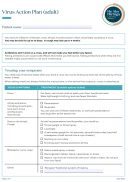
Virus action plan (adult) He Ako Hiringa, NZ, 2023 te reo Māori, Samoan, Tongan, Arabic, Hindi, Chinese (simplified)
Virus action plan (child) He Ako Hiringa, NZ, 2023 te reo Māori, Samoan, Tongan, Arabic, Hindi, Chinese (simplified)
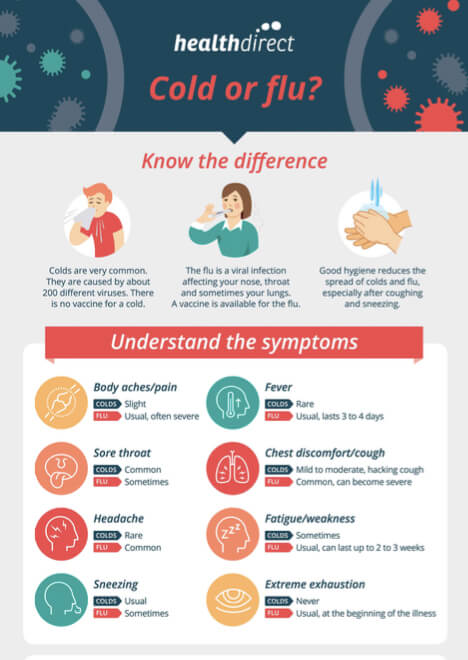
Health Direct, Australia, 2024
Credits: Healthify editorial team. Healthify is brought to you by Health Navigator Charitable Trust.
Reviewed by: Dr Sharon Leitch, GP and Senior Lecturer, University of Otago
Last reviewed:





